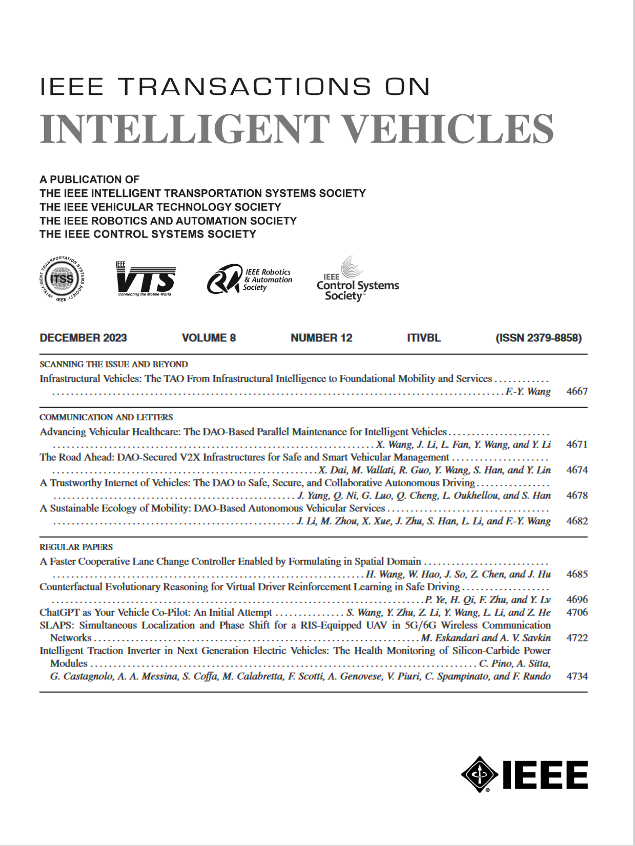Longitudinal Decoupling Control of Altitude and Velocity for a Fixed-Wing Aircraft
IF 14.3
1区 工程技术
Q1 COMPUTER SCIENCE, ARTIFICIAL INTELLIGENCE
引用次数: 0
Abstract
The longitudinal altitude and airspeed coordinated control is critical for unmanned fixed-wing aircrafts, especially during the taxiing landing process However, due to the strongly coupled relation of kinetic energy and gravitational potential energy, the precision longitudinal control is difficult. The traditional longitudinal control method based on PID (Proportional-Integral-Differential) usually adopts different control parameters at different flight stages. But the regulation of the control structure is complex, and some fluctuation may exist during the transition process, which will affect the control performance. The TECS (Total Energy Control System) method adopts the decoupling strategy that the throttle controls the total energy and the pitch angle controls the energy balance between kinetic and potential. However, the parameters-adjusting process is relatively complex and the adaptability to model nonlinearity is imperfect. Based on the INDI (Incremental Nonlinear Dynamic Inversion) method and the trim relation of the aircrafts, a longitudinal altitude/airspeed decoupling control method is proposed in this paper. Firstly, the process of control law design is systematically described. The core points of states balance and transition are described for the design of the method. Secondly, the feasibility and basic control effects of the control method are verified by simulations. During the simulation, a variable coefficient PI pseudo is proposed, to accommodate the requirements of accurate gliding and smooth grounding. Finally, to further verify the effectiveness and superiority of the proposed method, comparisons between the proposed method and the TECS method is carried out. From the simulation results, the in the sense of precise altitude control during auto landing process.固定翼飞机高度与速度的纵向解耦控制
纵向高度和空速协调控制是无人固定翼飞机的关键,特别是在滑行降落过程中,但由于其动能和重力势能的强耦合关系,使得纵向精确控制变得困难。传统的基于比例-积分-微分(PID)的纵向控制方法通常在不同的飞行阶段采用不同的控制参数。但控制结构的调节是复杂的,在过渡过程中可能存在一定的波动,从而影响控制性能。总能量控制系统(TECS)方法采用油门控制总能量,俯仰角控制动势能量平衡的解耦策略。但其参数调整过程相对复杂,对模型非线性的适应能力较差。基于INDI(增量非线性动态反演)方法和飞机的纵倾关系,提出了一种纵向高度/空速解耦控制方法。首先,系统地描述了控制律设计的过程。描述了该方法设计的核心要点——状态平衡和状态转换。其次,通过仿真验证了该控制方法的可行性和基本控制效果。在仿真过程中,为了满足精确滑翔和平稳着陆的要求,提出了变系数PI伪算法。最后,为了进一步验证所提方法的有效性和优越性,将所提方法与TECS方法进行了比较。从仿真结果来看,在自动着陆过程中实现了精确的高度控制。
本文章由计算机程序翻译,如有差异,请以英文原文为准。
求助全文
约1分钟内获得全文
求助全文
来源期刊

IEEE Transactions on Intelligent Vehicles
Mathematics-Control and Optimization
CiteScore
12.10
自引率
13.40%
发文量
177
期刊介绍:
The IEEE Transactions on Intelligent Vehicles (T-IV) is a premier platform for publishing peer-reviewed articles that present innovative research concepts, application results, significant theoretical findings, and application case studies in the field of intelligent vehicles. With a particular emphasis on automated vehicles within roadway environments, T-IV aims to raise awareness of pressing research and application challenges.
Our focus is on providing critical information to the intelligent vehicle community, serving as a dissemination vehicle for IEEE ITS Society members and others interested in learning about the state-of-the-art developments and progress in research and applications related to intelligent vehicles. Join us in advancing knowledge and innovation in this dynamic field.
 求助内容:
求助内容: 应助结果提醒方式:
应助结果提醒方式:


